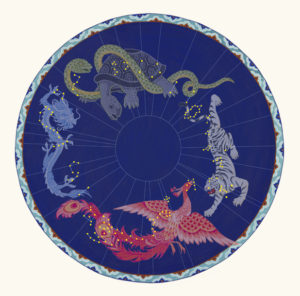The Common Pulse of Artistic Expression & Its Infinite Uniqueness
CAET was founded by Tony Zhou in Beijing to encourage dialogue between China and the world regarding the arts in therapy and education together with the more general area of art and human understanding. The decision to publish the journal in English, with selected passages in Chinese, was made to enable the discourse to happen within the language that currently generates most of the literature in these disciplines, and thus Eastern and Western Perspectives was added to the title. In the early stages of planning the journal, the mission was expanded to include China and its Asian neighbors in dialogue with all regions of the world.
Although the tradition of East-West scholarship is exemplary, the journal’s focus might also be paired with the four creatures or ‘images’ (tú xiàng图像) of Chinese mythology who stand at the four cardinal directions– in the East an Azure Dragon, a Vermilion Bird in the South, a White Tiger of the West, and the North’s Black Turtle. Each figure additionally represents a season in keeping with early China’s emphasis on living in attunement to nature and the universe. The images have also been important to Japan, Korea, and Vietnam and this affirms the transmission and spread of practices across borders as emphasized here. Good ideas have always had wings enabling them to fly from one place to another. They have inherent qualities that transplant, migrate, and spawn new creations. When working best, the process creates outside the lines used to separate realms of experience.

Four mythological creatures in Chinese constellations
We explore what is unique to China and neighboring regions to see if distinctive features of artistic expression and its applications can contribute to furthering practice within a worldwide and integral human community. Our editorial board includes colleagues in China together with others from throughout the world. The shared commitment to Asia by an international group from various world cultures is itself a manifestation of what I describe as a transcultural and reciprocal process. The prefix ‘trans’ is approached here literally as ‘across’ and I ask, are there aspects of artistic experience that are trans-human, and in some cases pan-human–including ‘all’ people? The term ‘transpersonal,’ which now tends to be exclusively identified with spiritual consciousness, can be reclaimed to signify a precise study of empirical features of human experience that exist beyond a particular person. Attentiveness to what might possibility span cultures, like the appeal of the paintings from the Nanjing Outsider Art Studio shown in Issue 4.1, in no way contradicts nor diminishes the unique and defining features and values of human communities. They are complementary like the ancient Taoist image of yin and yang holding the creative tension that is a basis of all life.
My commitment to CAET is informed by a longstanding kinship to classical and indigenous Chinese and Asian thought emphasizing the interdependence of all things, the animating flow of creative energy in the world, the ongoing process of persons creating themselves and their communities, and many other ideas and practices. These shared principles are complemented by the infinite and never-ending differences of individual and collective artistic expression, with no one ever identical, as in nature. My experience underscores how practical processes like the generation of creative energy (ch’i气) and the transformations of internal alchemy (nèi dān 内丹) characterize art healing worldwide. The same applies to physical acts and forces like rhythm, color, sound vibrations, enactment, and bodies moving in dance—qualities that my mentor Rudolf Arnheim described as a ‘common pulse.’ I find that people also share inhibitions and vulnerabilities when invited to express themselves artistically such as exclusionary notions about talent together with fears connected to personal exposure and vulnerability. Similarity, I see how group affirmation together with the commitment to working for the benefit of community, ideas deeply rooted throughout East Asia, diminish excessive self-consciousness and enhance full participation. In order to support the most complete inclusion in artistic expression I encourage people everywhere to approach it as a force of nature, as accessible to them as breath. https://nitro.edu.au/articles/2018/5/30/all-inclusive-art-making
I view CAET as offering opportunities to embrace the most specific and local expressions while simultaneously exploring how they may further learning and improve practice in other settings. For example, my approach to art and healing has emerged from my own particular methods when working with people. I am inspired by practices in distant places and times and I am especially influenced by ideas, like those mentioned above, that correspond to my experience, but what I ultimately do is always grounded in my own experimentation. The most local and individual ways that art heals stay closely connected to the immediate context and simultaneously move through us all.



